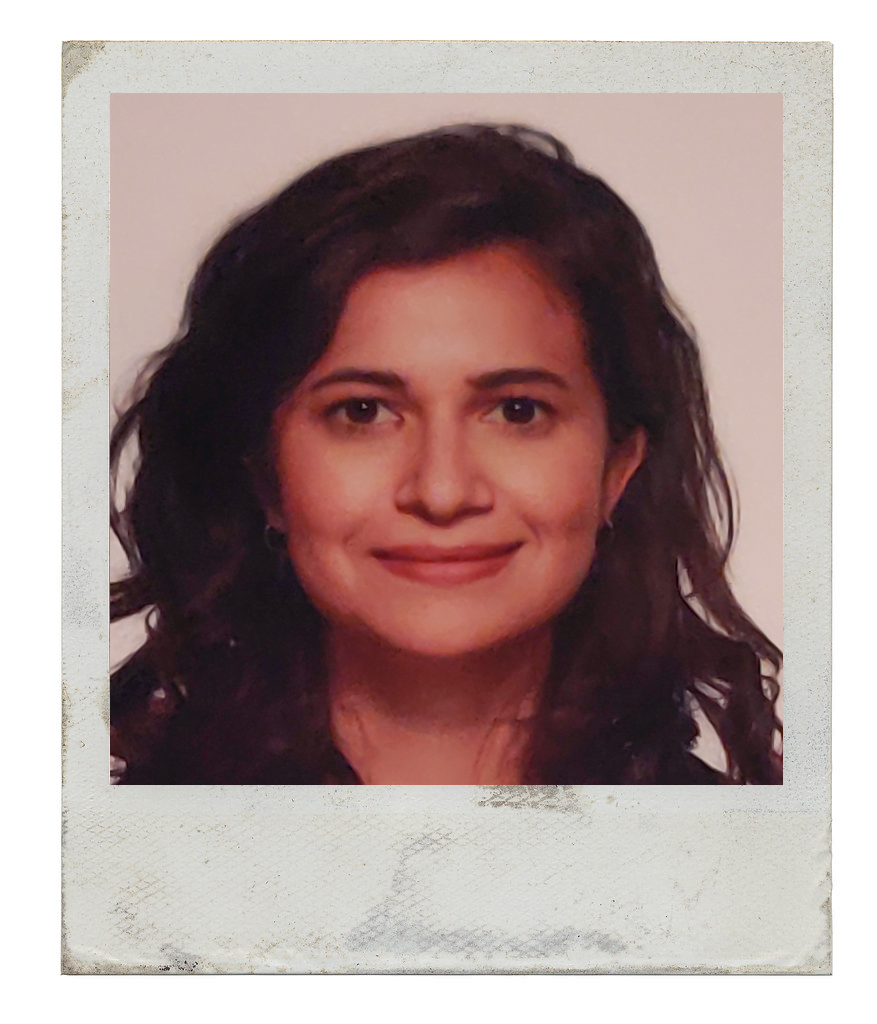Project: Bella & Broc
PROJECT BACKGROUND
The primary purpose of this project was to develop the concept for a media product able to support individuals in adopting more sustainable lifestyles. The end result was Bella & Broc: a mobile augmented reality (AR) application. The “green coach” helps individuals in reducing their food footprint, particularly offering alternatives to food waste and simple, practical actions for food preservation.
Research in consumer behaviour has shown that receiving coaching for food waste reduction significantly decreased the quantity of wasted food (Leverenz et al., 2019). The use of AR is explored alongside gamification elements to motivate users to form new habits. The application of gamification principles can lead individuals to develop competence and autonomy concerning food waste. It has been demonstrated that self-determination motivation can influence people’s behaviour towards sustainable practices (Cho, 2019). Moreover, evidence shows that AR can effectively nudge individuals to make more sustainable choices related to their food (Joerß et al., 2021; Lee et al., 2020). Finally, by receiving coaching and mentoring, individuals can substantially decrease their amount of food waste (Leverenz et al., 2019), as it increases their autonomy and competence towards the issue.
The problem
The food sector is among the industries that mainly contribute to carbon emissions. Although individuals are willing to reduce their food waste, they lack alternatives and practical assistance on how to do so.
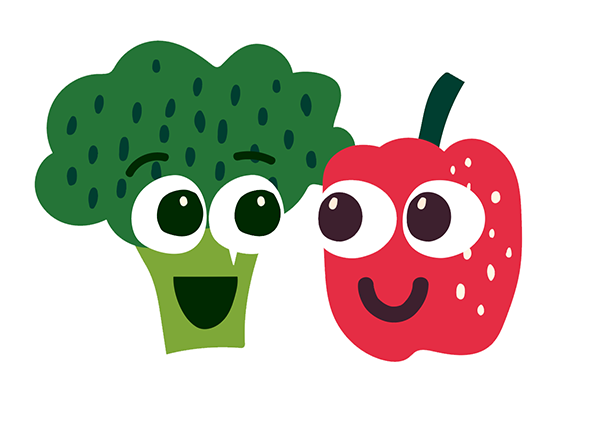
The goal
Design a media solution that supports users in reducing their food footprint.
The media solution should be designed in a way that it can handle more complex iterations in the future.
My role and resposibilities
Project lead and researcher. My responsibilities included:
- Project management (outline of the research, setting resposibilities accross team members, setting and managing deadlines)
- Facilitating brainstorm and alignment sessions
- Conducting interviews
- Conducting usability studies
- Analysing data sets
/* MENU */
- Empathise & Define
- Idea & Technology
- Time for prototype
- User testing
- Considerations for future iterations
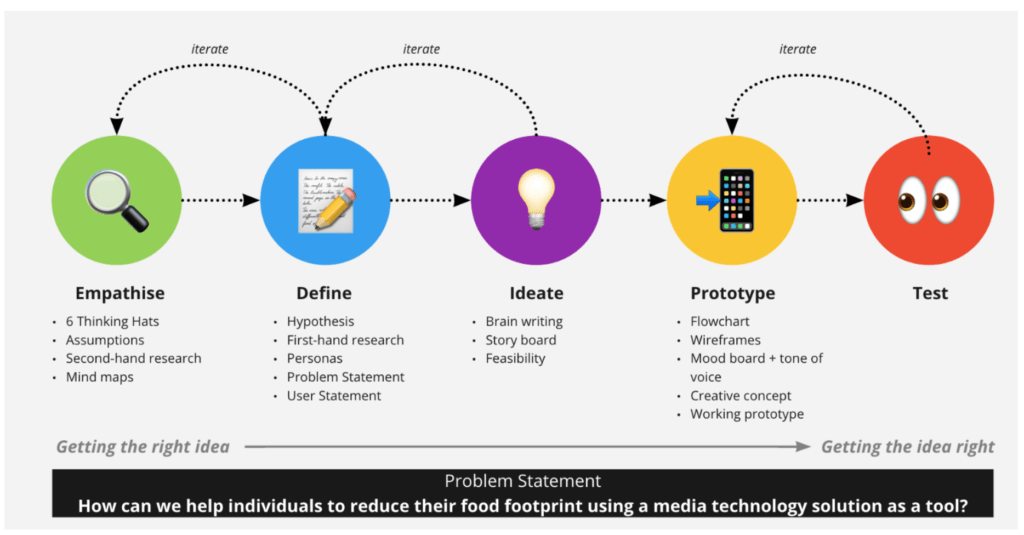
EMPHATISE & DEFINE
The challenge of this project was looking for solutions related to sustainability in the food chain. Therefore, the first step the team took was to investigate a broad overview of current hot topics under sustainability and explore their understanding by the general public. In this stage, the methods “Six Thinking Hats” and Mind mapping were applied to guide the discussion.


After discussion on how food and sustainability relate, the investigation was narrowed down to three main topics:
- Behaviour change towards sustainable food choices by educating users
- Reduction of food footprint
- Reduction of food waste
We made some assumptions before moving forward with research for validation. We also determined questions for performing interviews.


Second-hand research
Next, we performed extensive research covering relevant information regarding sustainability in the food chain, stakeholders understanding, trends, perspective analysis (in terms of possibilities for technology and innovation), as well as possible socio-economic impacts.
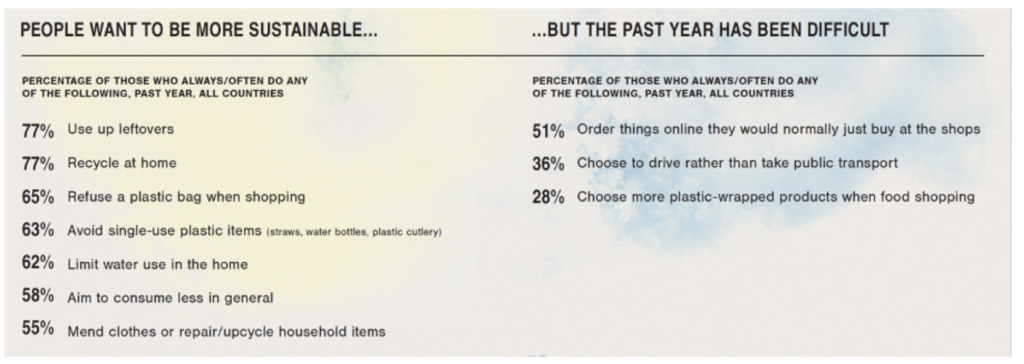
The main insights which were used for devising personas and guiding the design of the media solution:
- The younger generations are particularly engaged in sustainability, with evidence showing that these groups “could make an essential contribution to the debate among stakeholders on driving choices towards new production and consumption patterns” (Bollani et al., 2019).
- Preventing food waste can be an effective alternative to support sustainability, as this aspect has been appointed as a “global issue with major environmental and socio-economic implications” (Chammas & Yehya, 2020).
- “Understanding why food is wasted by consumers during meal occasions can lead to the development of waste reduction strategies that can be used for different foods and preservation methods” (Martindale & Schiebel, 2017)
- In connection to food waste, search terms related to food presentation have shown increasing interest over time, especially around March 2020, which could be explored as a consequence of COVID-19. The Netherlands appears in position 47 of the 55 countries with most searches related to the topic. (see Google Trends). Moreover, there is evidence that “frozen preservation can provide greater utilisation of food by consumers and reduce household food waste” (Martindale & Schiebel, 2017)
“Simply put, reducing food lost or waste means more food for all, less greenhouse gas emissions, lesspressure on the environment, and increased productivity and economic growth”
(FAO, 2020)
Competitor analysis
The competitive research was conducted to investigate and analyse the strengths and weaknesses of direct and indirect competitors in food waste. The two main findings from the competitor analysis were:
- There is no existing VR/AR app specialised for food waste
- Most zero waste apps do not incorporate social elements
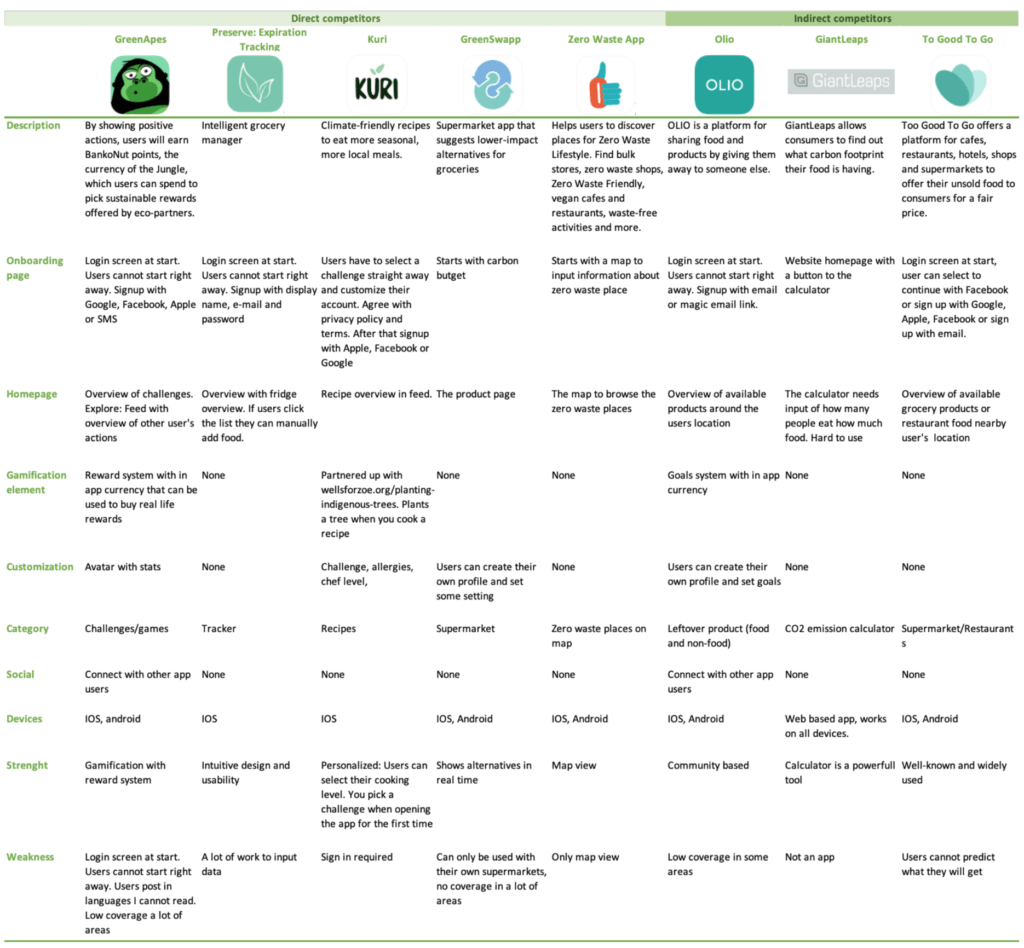
Perspective analysis
The purpose of the perspective analysis was to investigate which types of technologies are currently being used in projects related to sustainability and explore their potential in the design of our product. The main points which guide the design are described below:
- Current trends in technology can positively impact the development of more effective media solutions targeting sustainability issues. For example, the topics of Augmented Reality (AR), Artificial Intelligence (AI), Virtual Reality (VR), Big data and podcasts have been associated with sustainability with applications in various types of products and processes.
- Studies that focus on the application of augmented reality (AR) in sustainability-related topics have increased over recent years, particularly since 2017 (Abad-Segura et al., 2020).
- Research shows that consumers consider sustainability information from augmented reality-based recommendation agents (AR-RA) in their decision making. “AR-RA can be an effective tool in guiding consumers towards more sustainable shopping decisions, not only in the digital world but also in real physical stores” (Abad-Segura et al., 2020).
First-hand research: Interviews
Based on the assumptions formulated in the previous stage, we conducted interviews with individuals interested in sustainability (n=15).
GOAL OF THE INTERVIEW
- Build empathy with individuals interested in sustainability
- Discover interest and behaviour related to the reduction of meat consumption, food preservation and growing own food.
FINDINGS FROM THE INTERVIEWS
Insight #1: Most participants are willing to consume less meat.
Eating less meat has been associated with being healthy for most participants.
Insight #2: Fresh ingredients are more popular than preserved ones.
Most participants prefer to eat fresh food. Lentils and beans are the most common canned food. Cooling is the most popular way participants use to preserve their food.
Insight #3: Vegetable gardens are linked to childhood memories.
Several participants shared that they had access to a vegetable garden when they were younger with their parents and grandparents. It is common that when maintaining a vegetable garden, participants would also keep a compost bin. Additionally, limited space and time are the most cited reasons for not having a garden, although various participants are interested in a ‘shared’/ community garden model.
Insight #4: Fresh ingredients are more likely to go to waste than canned food.
Participants demonstrate more difficulty keeping track and utilising all the fresh ingredients they purchase rather than preserved food. Moreover, participants show interest in learning simple methods of food preservation, such as techniques for food storage. There is an expressive lack of alternatives to food waste.
Insight #5: Money is a concern for most participants.
Although participants prefer to eat fresh and organic food, they often opt for cheaper products. Solutions in which money could be saved are welcome.
Converge: Problem Statement
From this point, we extrapolated insights from the first and second-hand research to define the problem statement and user needs, moving to the converge stage of the problem exploration.
METHOD 1: HOW MIGHT WE
- How might we facilitate the process of reducing the food footprint of people who are already interested in the topic of sustainability?
- How might we make reducing food footprint appealing to young people?
- How might we explore the community aspect of reducing food footprint?
METHOD 2: PROBLEM STATEMENT + MEASURE OF SUCESS
Bella & Broc is designed to reduce personal / household food footprint. We have observed that individuals interested in sustainability are queen in engaging in activities that positively impact the environment. However, they often lack the guidance and facilitation to move beyond.
Success will be measured under the framework of See, Think, Do, Care (Kaushik, 2016). This measurement model can help bring insights into how users become aware, interact, and turn loyal to a product. The sections and types of interactions will be quantified and analysed for further product iterations. We will look for correlations between the types of users and their activities, as well as adoption and drop-out rates, seeking to identify patterns in data for expansion or elimination of features.

Problem Statement and Measurement Framework
METHOD 3: HYPHOTESIS FORMULATION
We believe that there are simple actions people can take to reduce their food footprint, ranging from passive to active engagement. We also observed there is an overwhelming number of apps focused on this mission that lack tailoring and could be enhanced with new types of technologies such as augmented reality. Individuals can become more conscious of their actions and change habits if they can use technology as a facilitator and exchange their experiences with other members of their community.
Personas
Based on the previous steps, we identified two types of patterns to be explored for creating the personas: the tendency to waste food and concern about eating healthy food. The personas also highlight the critical needs of the most important target groups to be addressed.
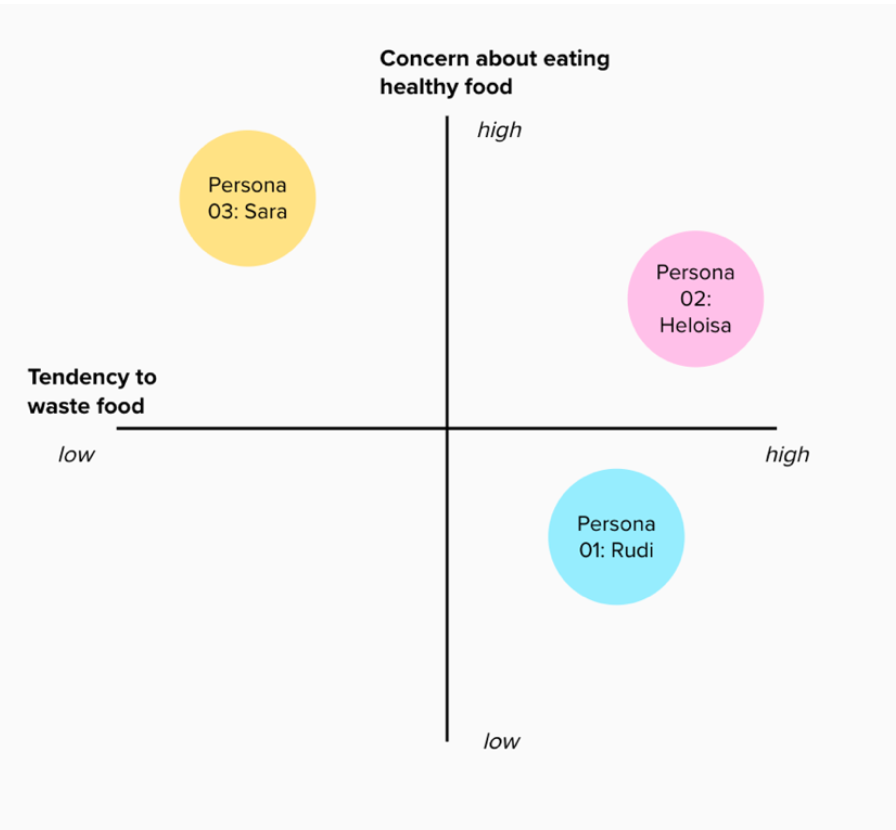
- High tendency to waste food: People in this category consume primarily fresh food, and their waste is usually related to not being able to finish what they buy in time.
- Low tendency to waste food: This group is more conscious about their food waste, so they try to plan their meals and shopping lists in advance.
- High concern about eating healthy food: They are likely to investigate the nutritional aspects of their food, planning their meals accordingly. This group gives preference to fresh ingredients and is likely to be more active towards reducing meat consumption.
- Low concern about eating healthy food: Although they are interested in reducing their own food footprint, these individuals are less concerned about the nutritional aspect of their diets.



From user insights to user statements
As the last step of the Converge Stage, the problem statement is translated as a user’s statement for each of the three personas. This is a critical step in the design process as it explicitly expresses the problem we are trying to address with the needs of the group. Finally, the user statements are translated according to the method How Might We (Dam & Siang, 2020).

IDEA & TECHNOLOGY
The investigation performed above resulted in the development of the concept for Bella & Broc: an AR mobile app that aims to engage individuals interested in sustainability by offering practical and fun alternatives to food waste. With the augmented reality mobile app, users will be able to scan plant-based food items and receive coaching tips for storing or cooking their groceries.
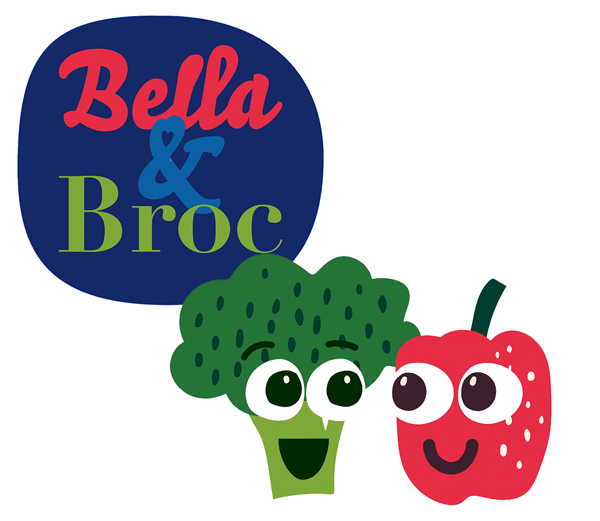
This particular choice is justified through a combination of both first and second-hand research. The use of AR is explored alongside gamification elements, with the intention to motivate users to form new habits. The application of gamification principles can lead individuals to develop competence and autonomy concerning food waste. It has been demonstrated that self-determination motivation can influence the behaviour of people towards sustainable practices (Cho, 2019). Moreover, evidence shows that AR can effectively nudge people to make more sustainable choices related to their food (Joerß et al., 2021; Lee et al., 2020). Finally, research shows that by receiving coaching and mentoring, individuals can substantially decrease their amount of food waste (Leverenz et al., 2019).
Storyboards
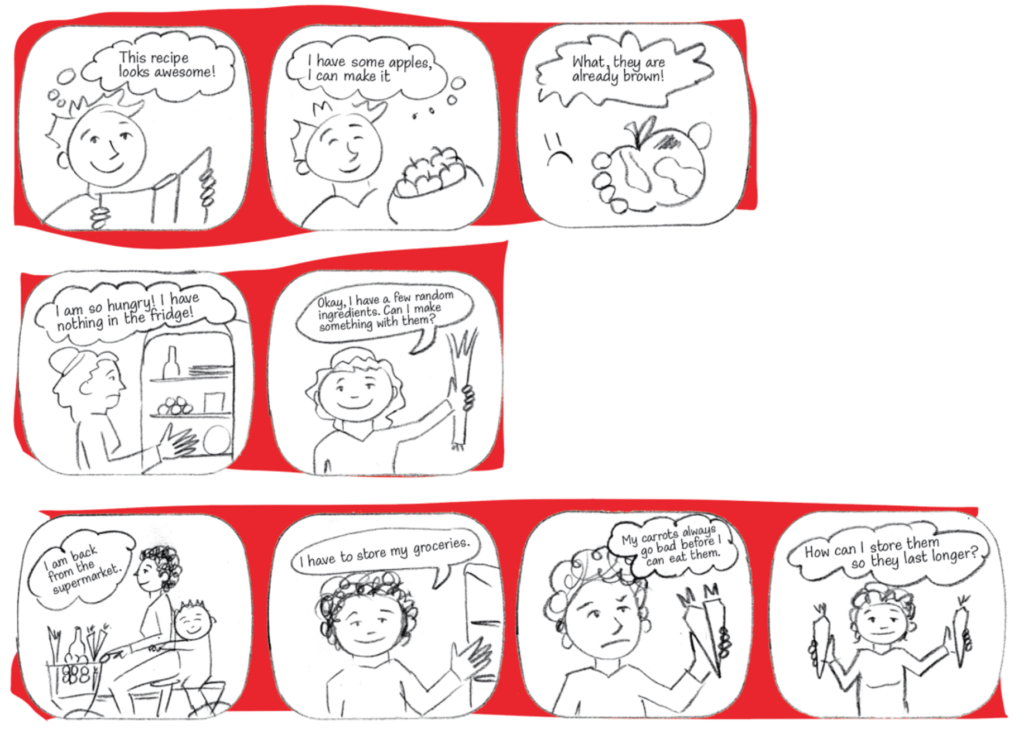

Defining product features and functions
The Brainwriting Method (Product Discovery Methods, n.d.) guided the ideation process followed for defining the scope of the media solution. Considering the learnings from both first and second-hand research, the following criteria have been established:
Criteria #1: The solution should offer users alternatives to food waste.
Criteria #2: The solution should incorporate recent developments in technology as in a facilitator/motivator role.
Criteria #3: The solution should offer room for the exploration of social elements.
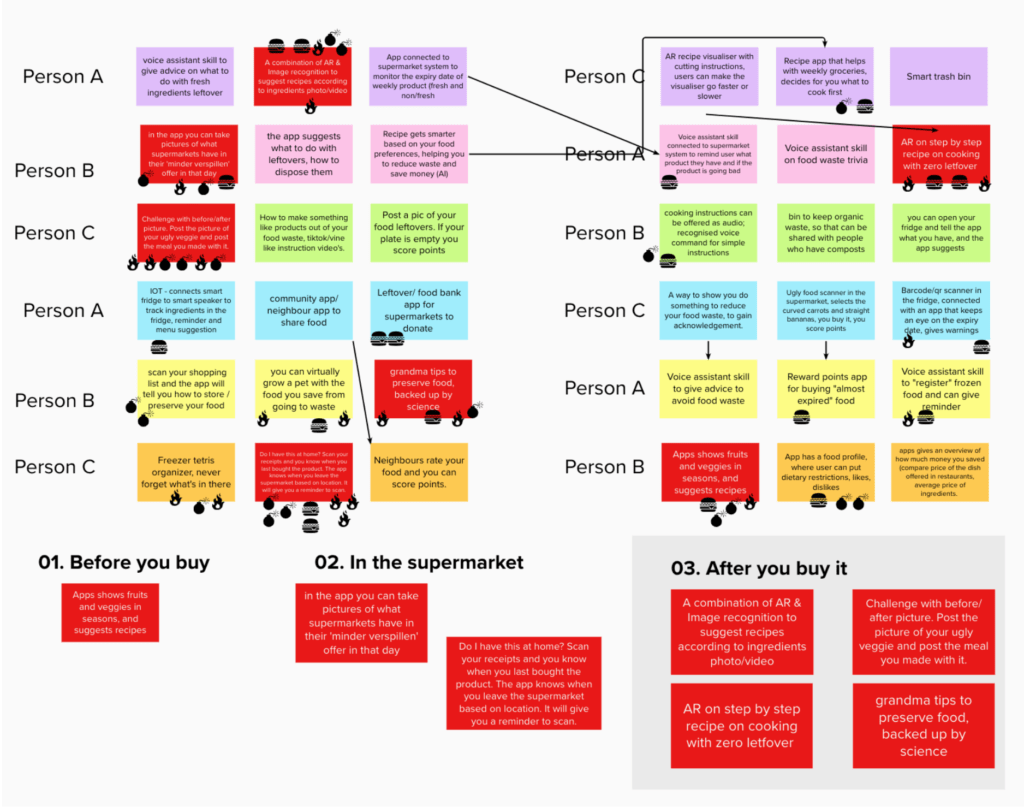
Lastly, in order to develop a successful media solution, it is essential to investigate the technological and non-technological feasibility elements of the application. For this matter, we investigated some aspects under the consumer, corporate, commercial and commons aspects, as it is represented in the image below. Additionally, we performed research on the state of the art use of AR, and how the technology could be used for registering food items, helping food preservation and supporting users cooking.

It’s time to PROTOTYPE
Based on the previous steps, three essential functions were identified for a minimum viable product (MVP): Food scanner, storage tips, and recipes suggestions. The features and content architecture are represented below. Aligned to that, we worked on low fidelity wireframes to represent the relationship within the content of the app before moving to the prototype.
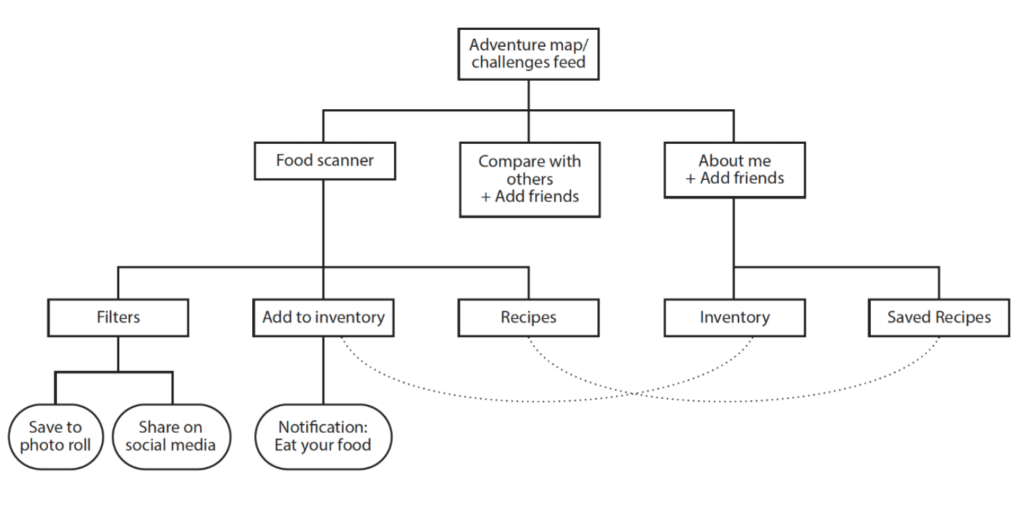
Creative concept & visual design choices
The visual design choices behind Bella & Broc were developed by the team member Joyce Overweg – and she did a great job, didn’t she? ????
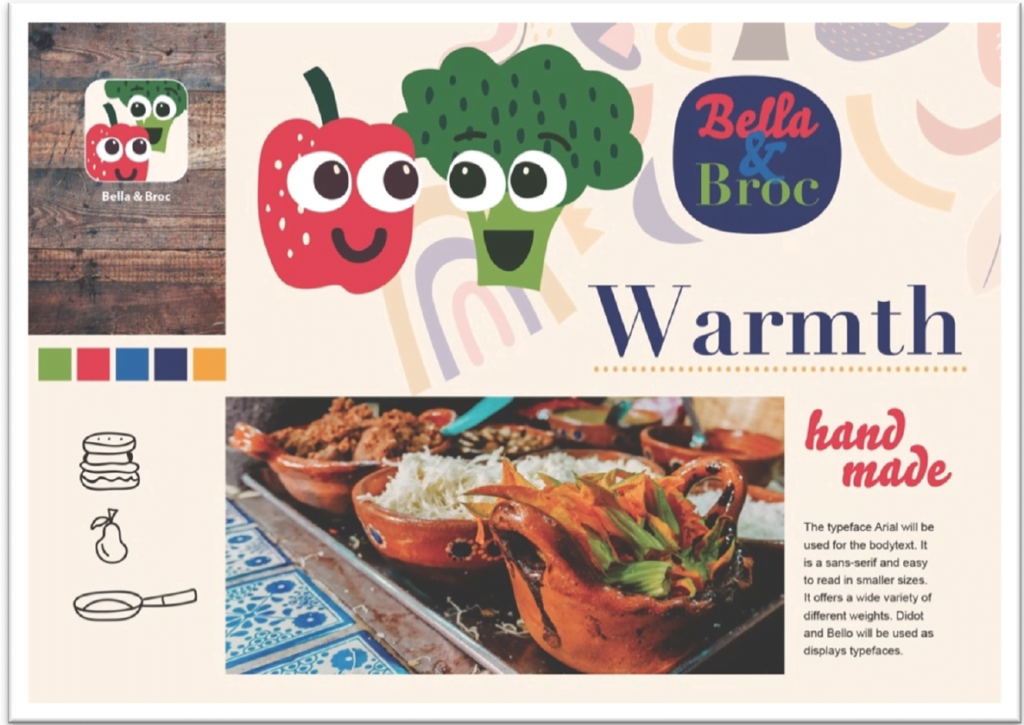
High-fidelity prototype
The high-fidelity prototype was developed in Adobe XD by the team member responsible for the visual design. Once the design was presented to the team, I was responsible to run an evaluation following the heuristic guidelines proposed by Nielsen (2020). The ten heuristics rules are used as a guideline to improve the usability, utility and desirability of media solutions, therefore the test was performed before the prototype was tested by users.
USER TESTING
So we arrive at my favourite part of the design process: user testing! ❤️ In this project we used three different methods collecting a total of 77 data points. Our objective with the tests was to gain insights from users regarding how they perceive the app and if the proposed interface is intuitive and easy to use.

Method 01: Cognitive Walkthrough
Cognitive walkthrough (Polson et al., 1990) was deployed to provide insights into how the app interface can be improved based on a specific set of tasks (sub-question 01). This is a task-oriented method focused on first-time users. Based on the functions that the digital prototype currently supports and the decision of features present in the MVP, the task selected for testing was to scan and preserve a banana. The test aims to identify if users are able to follow this scenario.
RESEARCH PARTICIPANTS
Sample of 6 participants interested in sustainability (two males, four females, between 27 – 36 years old, living in the Netherlands). Each participant has been correlated to a persona.
PROCEDURE
The participants were asked to perform the following task: Scan and preserve a banana. The researcher guides the participant by providing the next action step. Each action step is evaluated according to four cognitive walkthrough questions (Polson et al., 1990).

Method 2: Interviews
First-hand interviews were deployed to collect the perceptions of participants browsing through the prototype of the app (sub-questions 02 and 03).
RESEARCH PARTICIPANTS
Sample of 6 participants interested in sustainability (two males, four females, between 27 – 36 years old, living in the Netherlands). Each participant has been correlated to a persona.
PROCEDURE
The interviews happened after the cognitive walkthrough. Participants were given additional time to browse freely through the prototype. Researchers briefly explained the process and ask the participants to imagine a situation in which they are committed to reducing their food waste (role play).
Method 3: Scale evaluation
An additional questionnaire was designed based on the scale Attitudes Towards the Website (Interestingness) by Wang et al. (2007), combined with demographic information based on the personas (age, living situation and interest in sustainability). Although the scale proposed by Wang et al. (2007) refers to websites, the suggested scale items can give an overall representation of the interestingness of the app. Additionally, we seek to identify a correlation between attitude, age, self-reported interest in sustainability and living situation of the respondents. These correlations can potentially be used to indicate early adopters, thus leading to the exploration of marketing strategies.
RESEARCH PARTICIPANTS
In total, 65 individuals aged 18 -58 years old and living in the Netherlands were recruited via social media (n=65, M=26.52, SD=7.36). The sample consisted of individuals in different living situations according to the characteristics established in the research for personas.
PROCEDURE AND DATA ANALYSIS
Participants were asked to browse through the app for two to three minutes and then answer the questionnaire. Google Forms was used for data collection. SPSS was used for data analysis.
The data collected uses a Likert scale to analyse the attitude towards the app. For the analysis, first, the data was treated, converting the signals to numbers in order to translate the variables boring, fun and interesting to a numerical scale. The consideration of boring being a reverse scale was taken into account.
Next, the mean of the variables boring, fun and interesting was calculated to generate a score for attitude. Attitude can be interpreted on a scale from 1 to 7, in which 7 represents a very positive attitude, and 1 represents a very negative attitude. A dummy nominal variable PositiveAttitude was created as a Boolean type for cases where attitude is equal or higher to 5. This consideration has been applied in order to perform different tests of correlation.

Findings
The overall perception of the prototype of Bella & Broc as an alternative to help individuals to reduce food waste is positive considering the analysis from the interviews and scale evaluation.
Moreover, most participants from the interviews report that they see themselves significantly reducing food waste using the app, which goes in line with the defined problem statement.
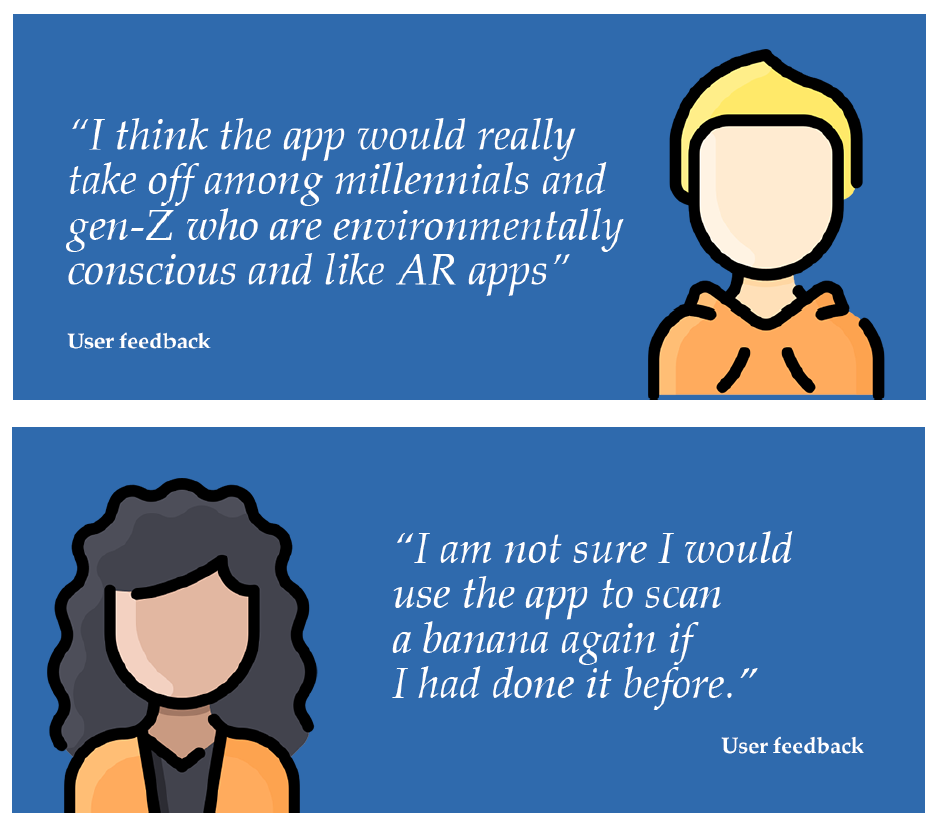
Expectations from the app
In general, participants find the app easy to use and navigate. The menu and buttons are placed in a prominent location and have straightforward functions. For example, the camera button is used to take pictures; the preserve button provides preservation suggestions. Participants can directly understand that the app’s primary purpose is: “to help reduce food waste by using the scan and preserve functions”. Additionally, participants expect to see more recommendations of healthy recipes as well as recipes suitable for children. Lastly, participants hope the scan and register function can help them track their food stock and avoid expired or stale food.
The intuitiveness of the interface
The task to scan and preserve a banana was performed without significant difficulties by all participants. Nevertheless, the icon used for the camera function can be improved as it confused some individuals. Improvement can also be made in the badges functionalities in order to drive recognition over recall and reduce cognitive load.
User experience
Overall, participants perceptions of the app are positive. The mission of Bella & Broc in helping individuals to reduce their food footprint received appraisal from most participants. Particularly acclaimed elements were the colourful and friendly design.
For the scale evaluation, the attitude towards the prototype was positive in 72.31% of the cases (n=65, M=5.31,SD=1.01). A positive attitude is considered a score of 5 or higher for the mean of the items NotBoring, Fun and Interesting. Self-reported interest in sustainability was positive in 90% of the cases (n=65, M=7.00, SD=1.42). It is, however, necessary to engage users with functionalities that go beyond the scan function.
Although the flowchart and wireframes already propose functionalities with a social aspect, these elements should be further explored and tested accordingly.
Identification of early adopters
The scale evaluation shows no association between age and positive attitude towards the app (x2(20)=22.25,p=0.327). Likewise, there is no correlation between a living situation and a positive attitude. Henceforth, the identification of early adopters should not be based on age and living situation. Still, interviewed participants report the perception that the app is likely to be adopted by young people who are excited about AR technology.
Lastly, influencers who cover the topic of sustainability can be a significant asset in driving early adopters. The correspondence bias theory shows that individuals tend to trust the opinion of influencers disregarding the situation (Han et al., 2020). Thus, even if influencers are given monetary compensation to promote the app, their followers are likely to trust their recommendation as Bella & Broc being an excellent alternative to help them to reduce food waste.
CONSIDERATIONS FOR FUTURE ITERATIONS
The following considerations can be explored for future iterations. They were devised based on the feedback of participants, expert testing, and overall evaluation of the prototype.
SUGGESTIONS FOR APP FUNCTIONALITIES
- Functionality to show how to cut vegetables in a more efficient way
- Interaction with supermarket scanners, as an alternative/complement of the scanning functionality
- Suggestions about vegetarian food, local and season products
- Reminder function with expected expiration date for scanner ingredients
- Option to share recipes with friends
- Option to provide food-pairing tips
SUGGESTIONS FOR IMPROVING USABILITY
- Improve usability label for challenges by using icons in combination with colours (reduce cognitive load)
- Develop onboarding session for first-time users (investigate alternative for progressive disclosure)
- The indicator on the food should be more visually distinctive from the shutter button
What I learned
This was the first time I worked on developing a product fully remote, with a team I didn’t meet in person before. I learned a lot about how to better collaborate with colleagues due to this experience.
I see improvements in leadership skills and how to engage all team members to collaborate in every new project I lead. I also love developing new skills in statistics and data analysis (yeah, I love numbers!) Quantitative methods get me excited ????

Do you want to know more about this project? Sure! Just get in touch ????
References
Abad-Segura, E., González-Zamar, M. D., Luque-de la Rosa, A. L. D. L., & Morales Cevallos, M. B. (2020). Sustainability of Educational Technologies: An Approach to Augmented Reality Research. Sustainability, 12(10), 4091. https://doi.org/10.3390/su12104091
Bollani, L., Bonadonna, A., & Peira, G. (2019). The Millennials’ Concept of Sustainability in the Food Sector. Sustainability, 11(10), 2984. https://doi.org/10.3390/su11102984
Chammas, G., & Yehya, N. A. (2020). Lebanese meal management practices and cultural constructions of food waste. Appetite, 155, 104803. https://doi.org/10.1016/j.appet.2020.104803
Cho, M. (2019). Campus sustainability. International Journal of Sustainability in Higher Education, 20(6), 1042–1060. https://doi.org/10.1108/ijshe-06-2018-0107
Dam, R. F., & Siang, T. Y. (2020). Define and Frame Your Design Challenge by Creating Your Point Of View and Ask How Might We. The Interaction Design Foundation. https://www.interaction-design.org/literature/article/define-and-frame-your-design-challenge-by-creating-your-point-of-view-and-ask-how-might-we
FAO. (2020, September 29). European Union. Food and Agriculture Organization of the United Nations. http://www.fao.org/save-food/regional/europeanunion/en/
Han, Y., Liu, Y., & Loewenstein, G. F. (2020). Correspondence Bias. SSRN Electronic Journal. Published. https://doi.org/10.2139/ssrn.3733326
Joerß, T., Hoffmann, S., Mai, R., & Akbar, P. (2021). Digitalization as solution to environmental problems? When users rely on augmented reality-recommendation agents. Journal of Business Research, 128, 510–523. https://doi.org/10.1016/j.jbusres.2021.02.019
Kaushik, A. (2016, November 12). See, Think, Do: A Content, Marketing, Measurement Business Framework. Occam’s Razor by Avinash Kaushik. https://www.kaushik.net/avinash/see-think-do-content-marketing-measurement-business-framework
Lee, J., Kaipainen, K., & Väänänen, K. (2020). Local foodie. Proceedings of the 23rd International Conference on Academic Mindtrek, 110–119. https://doi.org/10.1145/3377290.3377298
Leverenz, D., Moussawel, S., Maurer, C., Hafner, G., Schneider, F., Schmidt, T., Kranert, M. (2019). Quantifying the prevention potential of avoidable food waste in households using a self reporting approach, Resources, Conservation and Recycling, 150 (November 2019), Article No. 104417.
Martindale, W., & Schiebel, W. (2017). The impact of food preservation on food waste. British Food Journal, 119(12), 2510–2518. https://doi.org/10.1108/bfj-02-2017-0114
Nielsen, J. (2020, November 15). 10 Usability Heuristics for User Interface Design. Nielsen Norman Group. https://www.nngroup.com/articles/ten-usability-heuristics/
Polson, P. G., Lewis, C., Rieman, J., & Wharton, C. (1990). Cognitive walkthroughs: a method for theory-based evaluation of user interfaces. International Journal Man-Machine Studies, 741–773. http://sonify.psych.gatech.edu/~ben/references/polson_cognitive_walkthroughs_a_method_for_theory-based_evaluation_of_user_interfaces.pdf
Product Discovery Methods. (n.d.). Brainwriting. Retrieved 13 May 2021, from https://pdmethods.com/brainwriting/
Wang, L. C., Julie Baker, J. A., & Wakefield, K. (2007). Can a Retail Web Site Be Social. Journal of
Wunderman Thompson. (2021, April). Regeneration Rising: Sustainability Futures. https://intelligence.wundermanthompson.com/trend-reports/regeneration-rising-sustainability-futures/
